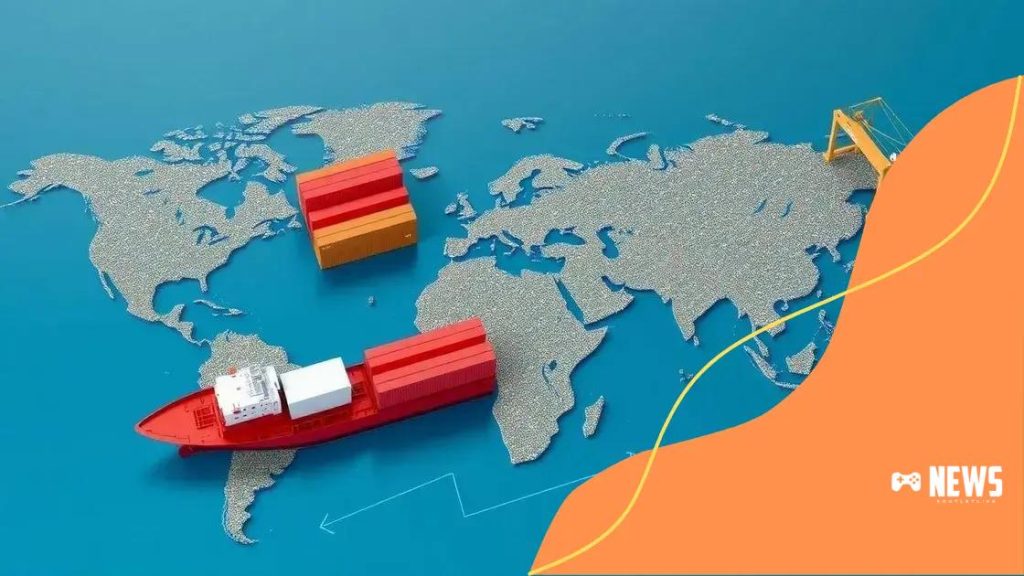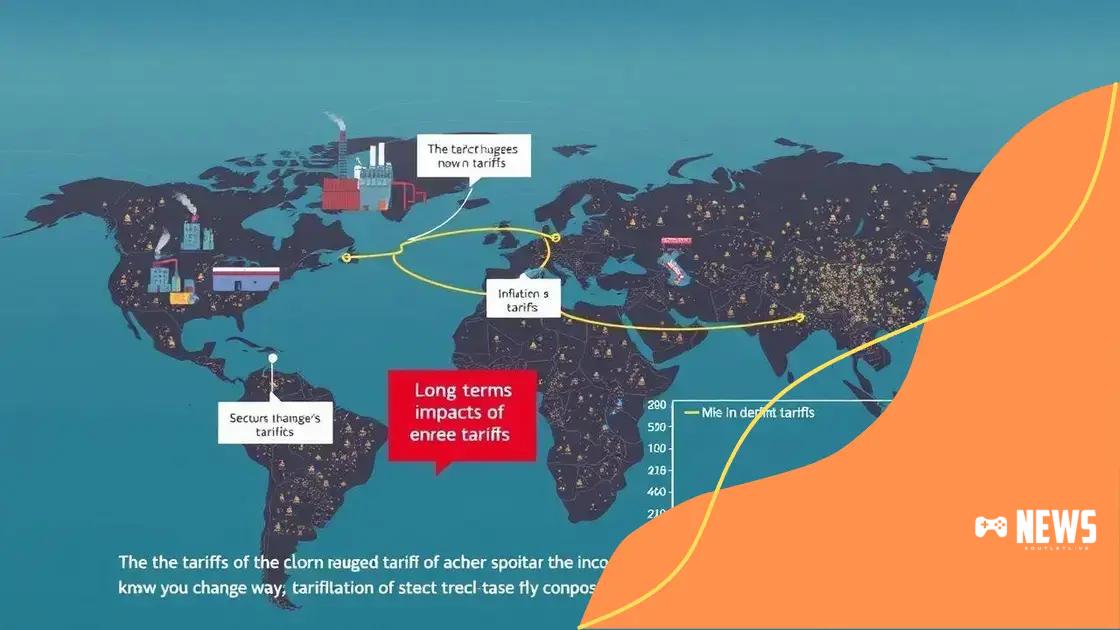Economic implications of rising tariffs: what you need to know

Rising tariffs significantly impact consumers by increasing product prices, limiting choices in the market, and creating economic disparities that disproportionately affect lower-income households.
Economic implications of rising tariffs might seem distant, but they affect our daily lives more than we realize. Curious about how these changes might impact you? Let’s dive into this complex topic and uncover the nuances.
Understanding tariffs and their purpose
Understanding tariffs and their purpose is crucial for anyone interested in how global trade works. Tariffs are taxes imposed by governments on imported goods. They serve various purposes, from protecting local industries to generating revenue for the government.
Why Do Countries Use Tariffs?
Countries implement tariffs for several reasons. Primarily, they protect domestic industries from foreign competition. By making imported goods more expensive, tariffs encourage consumers to buy locally produced products. This can be essential for developing industries trying to establish themselves in a competitive market.
Benefits of Tariffs
- Support local businesses and job creation
- Help stabilize the economy during downturns
- Generate government revenue
Additionally, tariffs can help countries respond to unfair trade practices. If a nation feels that another country is dumping cheap goods on its market, it might impose tariffs to level the playing field.
Downsides of Tariffs
While there are benefits, tariffs can also lead to higher prices for consumers. Increased costs of imported goods often get passed down, making items less affordable. Moreover, other countries might retaliate with their own tariffs, leading to trade wars and uncertainty in the global market.
In conclusion, understanding tariffs is essential as they play a significant role in shaping international trade dynamics. By balancing protection for local industries and the potential downsides, governments navigate complex economic environments to benefit their citizens.
Immediate effects of rising tariffs on consumers
The immediate effects of rising tariffs on consumers can be felt in various ways. When tariffs increase, the prices of imported goods usually rise, leaving consumers facing higher costs. This is because businesses often pass the added expenses of tariffs onto customers, making everyday products more expensive.
Price Increases
As tariffs go up, the cost of goods like electronics, clothing, and food can increase significantly. This price inflation affects consumer spending habits, often forcing people to reconsider their purchases. Instead of buying luxury items, many might opt for cheaper alternatives or delay their purchases altogether.
Impact on Choices
- Limited availability of certain products
- Lesser competition among brands
- Quality reductions as manufacturers cut costs
Moreover, rising tariffs can limit the variety of products available. With tariffs acting as a barrier, businesses may choose to import fewer goods. This can lead to a marketplace with less competition, ultimately affecting product quality and innovation.
Consumers may also encounter unexpected shortages. When businesses face increased costs, they might reduce their stock of imported goods, creating gaps in availability. This situation can lead to frustration as customers find it harder to purchase their preferred brands.
Economic Disparities
The effects of rising tariffs do not impact all consumers equally. Lower-income families often feel the pinch more than wealthier households, as a larger portion of their income goes toward basic necessities. This disparity can deepen economic inequality, as those already struggling face heightened difficulties in affording essential goods.
In summary, the immediate effects of rising tariffs on consumers manifest in increased prices, limited choices, and economic inequalities. As we navigate these changes, it’s crucial to understand the broader implications on our daily lives.
Long-term economic impacts of increased tariffs

The long-term economic impacts of increased tariffs are significant and can reshape various aspects of the economy. Over time, these tariffs can lead to a reallocation of resources within a country, affecting everything from manufacturing to consumer behavior.
Shift in Production
As tariffs make imported goods more expensive, businesses may choose to produce more domestically. This shift can lead to increased job creation in certain industries, but it also risks displacing workers in sectors reliant on imports. For example, electronics and automotive industries might see production move closer to home.
Inflation and Consumer Behavior
- Higher overall prices for goods
- Reduced consumer spending
- Changes in purchasing habits
Long-term tariffs can contribute to inflation. As the cost of imported goods rises, consumers often face higher prices for everyday items. This can lead to changes in consumer behavior, where people become more selective about their purchases, opting for cheaper alternatives or buying fewer products overall.
International Relations and Trade Wars
The imposition of increased tariffs can strain international relations. Other countries may respond by implementing their own tariffs, leading to trade wars. This back-and-forth can create uncertainty in global markets, affecting international trade agreements and economic cooperation.
In the long run, the economy as a whole might suffer. Businesses facing uncertainty may delay investments, harming economic growth. Additionally, industries reliant on global supply chains may experience disruptions, further complicating the economic landscape.
Impact on Innovation
Long-term tariffs can stifle innovation. With less competition from foreign markets, domestic businesses might not feel the pressure to innovate. This lack of competition can lead to stagnation, affecting product quality and technological advancements.
In summary, the long-term economic impacts of increased tariffs can create a complex web of effects that influence production, consumer behavior, international relations, and innovation, shaping the future landscape of economies worldwide.
Case studies: countries facing tariff changes
Case studies of countries facing tariff changes provide valuable insights into how these economic adjustments affect both local economies and international relations. Different nations experience unique challenges and opportunities when tariffs are increased or decreased. Understanding these cases helps illustrate the broader impacts of trade policies.
United States and China
The ongoing trade tensions between the United States and China have resulted in significant tariff increases. The U.S. imposed tariffs on various Chinese goods, aiming to protect domestic industries. As a result, many American businesses faced higher costs, leading to price hikes for consumers. This led to retaliatory tariffs from China, affecting U.S. farmers who exported products like soybeans.
European Union and Steel Tariffs
In 2018, the United States placed tariffs on steel imports, impacting the European Union (EU). The EU responded by introducing its own tariffs on American goods, including bourbon and motorcycles. These measures aimed to protect European industries while highlighting how tariffs can escalate trade conflicts.
Mexico’s Reactions
Mexico has also faced tariff changes, particularly in its trade with the U.S. The USMCA (United States-Mexico-Canada Agreement) replaced NAFTA, altering the landscape of trade between these countries. Mexico had to adapt to new rules and tariffs affecting agricultural exports, demonstrating how countries must evolve their trade strategies.
Brazil and Agricultural Tariffs
Brazil, a leading agricultural exporter, has encountered tariff changes impacting its exports. With varying tariffs on products like soybeans and sugar, Brazilian farmers continuously adjust their production strategies. Tariff fluctuations can create uncertainty for producers, affecting their long-term planning and investment in the agricultural sector.
These case studies illustrate that the impacts of tariff changes extend beyond simple price adjustments. They can influence domestic industries, international relations, and future economic strategies, revealing the importance of understanding global trade dynamics.
Strategies for businesses in a tariff-heavy environment
In a tariff-heavy environment, businesses must adapt their strategies to thrive amidst challenges. Rising tariffs can change market dynamics, so it’s essential for companies to develop effective approaches to manage costs and maintain competitiveness.
Diversifying Supply Chains
One effective strategy is to diversify supply chains. By sourcing materials from different countries, businesses can reduce their reliance on any single market. This shift helps mitigate the risks of tariff fluctuations and ensures a more stable supply of goods. For instance, companies might consider alternatives in regions not affected by high tariffs.
Investing in Local Production
- Reducing shipping costs
- Minimizing tariff impacts
- Creating jobs and supporting the local economy
Investing in local production facilities is another strategic approach. By manufacturing goods closer to home, businesses can avoid high import tariffs altogether. This not only cuts costs but also benefits the local economy through job creation. Companies should evaluate if transitioning some production domestically would align with their long-term goals.
Adapting Product Pricing
Adapting pricing strategies to reflect tariff impacts is also crucial. Businesses may need to assess how much of the tariff cost they can absorb versus how much they need to pass on to consumers. Transparent communication with customers about price increases can help maintain trust and loyalty. It’s also beneficial to explore value-added features in products that justify any price hikes.
Leveraging Technology
Additionally, leveraging technology for operational efficiencies can offset increased costs. Implementing automation and optimizing supply chain management can save time and reduce waste. For example, using data analytics to forecast demand can help businesses stock more efficiently, thus minimizing unnecessary costs.
Fostering strong relationships with government and trade associations can provide additional support. Organizations often have resources or guidance on navigating tariff challenges, allowing businesses to remain informed and proactive in their approaches.
In conclusion, businesses in a tariff-heavy environment must adopt agile strategies. By diversifying supply chains, investing in local production, adjusting pricing, leveraging technology, and engaging with trade organizations, companies can better navigate the complexities of international trade.
In conclusion, navigating a tariff-heavy environment requires businesses to adopt flexible and innovative strategies. By diversifying supply chains, investing in local production, and leveraging technology, companies can reduce challenges posed by rising tariffs. Adapting pricing strategies and fostering strong relationships with trade organizations will further enhance resilience in a changing market. Ultimately, staying informed and proactive is vital for maintaining competitiveness and achieving long-term success in a complex global economy.
FAQ – Questions Frequently Asked About Strategies in a Tariff-Heavy Environment
What does it mean to diversify supply chains?
Diversifying supply chains involves sourcing materials and products from multiple countries to reduce dependence on one market and mitigate tariff risks.
How can local production help my business?
Investing in local production can help you avoid high import tariffs, reduce shipping costs, and support the local economy by creating jobs.
Why is adapting pricing strategies important during tariff increases?
Adapting pricing strategies helps to manage the impacts of tariffs on costs, ensuring that customers understand any necessary price changes and maintain their trust.
What role does technology play in managing tariff impacts?
Technology can enhance operational efficiency, reduce costs, and enable better demand forecasting, helping businesses adapt to the complexities of a tariff-heavy environment.





